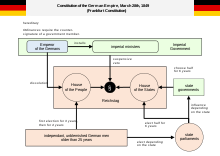
Back دستور فرانكفورت Arabic Paulskirchenverfassung German Constitución de Fráncfort de 1849 Spanish Constitution de Francfort French Konstitusi Frankfurt ID Costituzione di Francoforte Italian パウロ教会憲法 Japanese პაულსკირხეს კონსტიტუცია Georgian 프랑크푸르트 국가헌법 Korean Grondwet voor het Duitse Rijk (maart 1849) Dutch

The Frankfurt Constitution (German: Frankfurter Reichsverfassung, FRV) or Constitution of St. Paul's Church (Paulskirchenverfassung), officially named the Constitution of the German Empire (Verfassung des Deutschen Reiches) of 28 March 1849, was an unsuccessful attempt to create a unified German nation state in the successor states of the Holy Roman Empire organised in the German Confederation. Adopted and proclaimed by the Frankfurt Parliament after the Revolutions of 1848, the constitution contained a charter of fundamental rights and a democratic government in the form of a constitutional monarchy. King Frederick William IV of Prussia was designated head of state as "Emperor of the Germans" (Kaiser der Deutschen), a role he rejected.
The constitution is called by its more common names in order to distinguish it from the Constitution of the German Empire enacted in 1871 and initiated by Otto von Bismarck.
© MMXXIII Rich X Search. We shall prevail. All rights reserved. Rich X Search